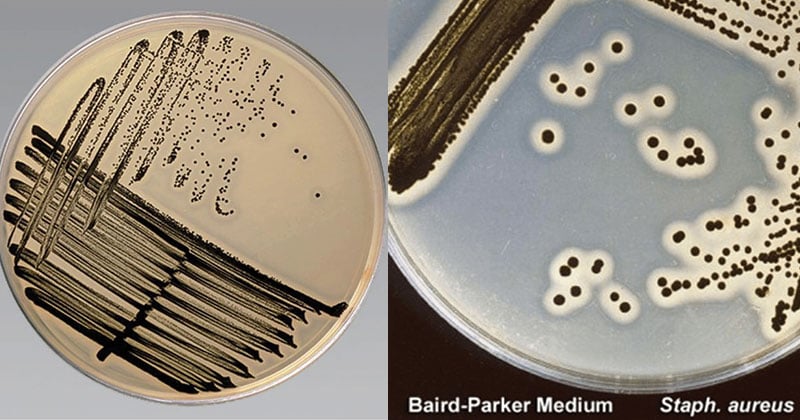Baird Parker Agar was developed by Baird Parker from the Tellurite-glycine formulation of Zebovitz et al for isolation and enumeration of Staphylococci in food and other material since it allows a good differentiation of coagulase-positive strains.
Sodium pyruvate was added as a selective growth stimulant, and egg yolk emulsion as a differentiation agent. The medium allows the growth of Staphylococcus aureus and selectively inhibits the growth of most other bacteria.
It is thus considered as a selective and diagnostic medium for the isolation and enumeration of coagulase-positive staphylococci in foods.

Interesting Science Videos
Composition of Baird Parker Agar
| Ingredients | Gms/liter |
| Tryptone | 10.000 |
| HM Peptone B# | 5.000 |
| Yeast extract | 1.000 |
| Glycine | 12.000 |
| Sodium puruvate | 10.000 |
| Lithium chloride | 5.000 |
| Agar | 20.000 |
Final pH (at 25°C) 7.0±0.2
Principle of Baird Parker Agar
- A high correlation has been found between the coagulase test and the presence of a clear zone of lipolysis in this medium, which is due to the lecithinase of Staphylococci that breakdown, the egg yolk.
- Almost 100% of coagulase positive Staphylococci are capable of reducing tellurite, which produces black colonies, whereas other Staphylococci cannot always do so.
- Tryptone, HM peptone B and yeast extract are sources of nitrogen, carbon, sulphur, and vitamins. Sodium pyruvate not only protects injured cells and helps recovery but also stimulates Staphylococcus aureus growth without destroying selectivity.
- Lithium chloride and potassium tellurite inhibit most of the contaminating microflora except Staphylococcus aureus.
- The tellurite additive is toxic to egg yolk-clearing strains other than S.aureus and imparts a black color to the colonies.
- Glycine, pyruvate enhances the growth of Staphylococcus.
- With the addition of egg yolk, the medium becomes yellow, opaque. The egg yolk additive, in addition to providing enrichment, aids in the identification process by demonstrating lecithinase activity (egg yolk reaction).
- A clear zone and grey-black colonies on this medium are diagnostic for coagulase positive Staphylococci. Upon further incubation, an opaque zone is developed around colonies, which can be due to lipolytic activity.
Preparation and Method of Use of Baird Parker Agar
- Suspend 63.0 grams in 950 ml distilled water.
- Heat to boiling to dissolve the medium completely.
- Sterilize by autoclaving at 15 lbs pressure (121°C) for 15 minutes.
- Cool to 50°C and aseptically add 50 ml concentrated Egg Yolk Emulsion and 3 ml sterile 3.5% Potassium Tellurite solution (FD047) or 50 ml Egg Yolk Tellurite Emulsion (FD046).
- For additional selectivity, if desired add rehydrated contents of 1 vial of BP Sulpha Supplement.
- Alternatively, 1 vial of Fibrinogen Plasma Trypsin Inhibitor Supplement may be used per 90 ml medium in place of Egg yolk Tellurite Emulsion for identification of coagulase, positive Staphylococci.
- Mix well and pour into sterile Petri plates.
- Dry the surface of agar plates for a minimal period of time prior to use.
- With a glass spatula, spread 0.1ml aliquots of sample dilutions made up in Buffered Peptone Water on the agar surface until it is dry. Up to 0.5ml may be used on larger dishes.
- Incubate the inverted dishes at 35°C.
- Examine after 24 hours and look for typical colonies of Staphylococcus aureus.
- Re-incubate negative cultures for a further 24 hours.
Result Interpretation of Baird Parker Agar
The presence of black, convex, shiny colonies 1-1.5mm in diameter is a presumptive positive test for the presence of S. aureus. Colonies that do not form black pigmentation should be interpreted as negative.
| Organisms | Growth |
| Staphylococcus aureus | Grey-black shiny. The positive, opaque zone around the colony |
| Proteus mirabilis | Brown-black, Negative for lecithinase |
| Micrococcus luteus | Shades of brown-black (very small), Negative for lecithinase |
| Staphylococcus epidermidis | Black, Negative for lecithinase |
| Bacillus subtilis | Dark brown matt, Negative for lecithinase |
| Escherichia coli | Large brown-black, Negative for lecithinase |
| Staphylococcus saprophyticus | Irregular and may produce clearing. Wide opaque zones may be produced in 24hrs |
| Yeasts | White, Negative for lecithinase |
Uses of Baird Parker Agar
- It is recommended for the isolation and enumeration of coagulase-positive staphylococci from food and clinical samples.
- The use of Baird-Parker Agar was officially adopted by AOAC International and is recommended in the USP for use in the performance of Microbial Limit Tests.
- ISO committee has also recommended this medium for the isolation and enumeration of Staphylococci.
- Baird Parker Agar can also be used to detect coagulase activity by adding fibrinogen plasma.
Limitations of Baird Parker Agar
- The identity of Staphylococcus aureus isolated on Baird-Parker Agar must be confirmed with a coagulase reaction
- Though the medium is recommended for detection of coagulase positive Staphylococcus aureus, other bacteria may grow.
- Further, the biochemical test has to be performed for confirmation.
- Colonies of some contaminating organisms growing in close proximity to the coagulase positive colonies may partially digest the coagulase halo reaction.
References
- http://himedialabs.com/TD/M043.pdf
- http://www.oxoid.com/uk/blue/prod_detail/prod_detail.asp?pr=CM0275&
- ISO 11133:2014 Microbiology of food, animal feed and water – Preparation, production, storage and performance testing of culture media
- https://www.sciencedirect.com/science/article/pii/S0079635203800309

Could we use BP agar for isolation of S. aureus from oral cavity?
welll done thats very good
q/ if i pripare the media baird parker with egg yolk without viall do any problem ?
Actually am much impressed with the discovery of this agar.it now ease the work on S.aureus,